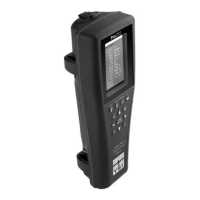43
Calibration
pH Calibration 3-Point
1. Always start the calibration with pH 7 buffer. Fill the calibration cup
to the appropriate level with pH 7 buffer solution.
2. With the probe guard installed, carefully immerse the probe into
the buffer solution. Make sure both the pH sensor and temperature
sensor are submerged.
3. Push the
Cal
key; then select pH or pH/ORP.
4. The Calibration value will automatically be adjusted based on
the selected buffer and temperature. Alternatively, the Calibration
value can be manually entered..
5. Wait for the pH mV and temperature readings to stabilize; the
white line on the graph should be flat for about 40 seconds.
6. Select Accept Calibration and press the
ENTER
key. “Ready for cal
point 2” will be displayed in the message area.
7. Rinse the probe and calibration cup. Fill to the appropriate level
with either pH 10 or pH 4 buffer solution; it doesn’t matter which
one comes next.
8. Immerse the probe into the buffer solution. The Calibration value
will automatically be adjusted based on the selected buffer and
temperature.
9. Wait for the pH mV and temperature readings to stabilize; the
white line on the graph should be flat for about 40 seconds.
10. Select Accept Calibration and press the
ENTER
key. “Ready for cal
point 3” will be displayed in the message area.
Figure 58 Calibrate pH 2- or 3-point
3.8
pH/ORP
Observe the pH mV readings during calibration to understand the condition and response of the pH sensor. In buffer
7, pH mVs should be between -50 and +50. In pH4 buffer, the mV reading should be 165 to 185 mV higher than the
reading in pH 7 buffer. In pH 10 buffer, the mV reading should be 165 to 185 mV lower than the reading in pH 7 buffer.
The theoretically ideal slope is -59 mV/pH unit.
1-Point
While a 1-point pH calibration is possible, this calibration procedure adjusts only the pH offset and leaves the
previously determined slope unaltered. This should only be performed if you are adjusting a previous 2-point or
3-point calibration.
2-point
Perform a 2-point pH calibration if the pH of the media to be monitored is known to be either basic or acidic. In this
procedure, the pH sensor is calibrated with a pH 7 buffer and a pH 10 or pH 4 buffer depending upon the pH range
you anticipate for your water to be sampled.
3-point
Perform a 3-point pH calibration to assure maximum accuracy when the pH of the environmental water cannot be
anticipated or fluctuates above and below pH 7. In this procedure, the pH sensor is calibrated with pH 7, pH 10, and pH
4 buffer solutions.

